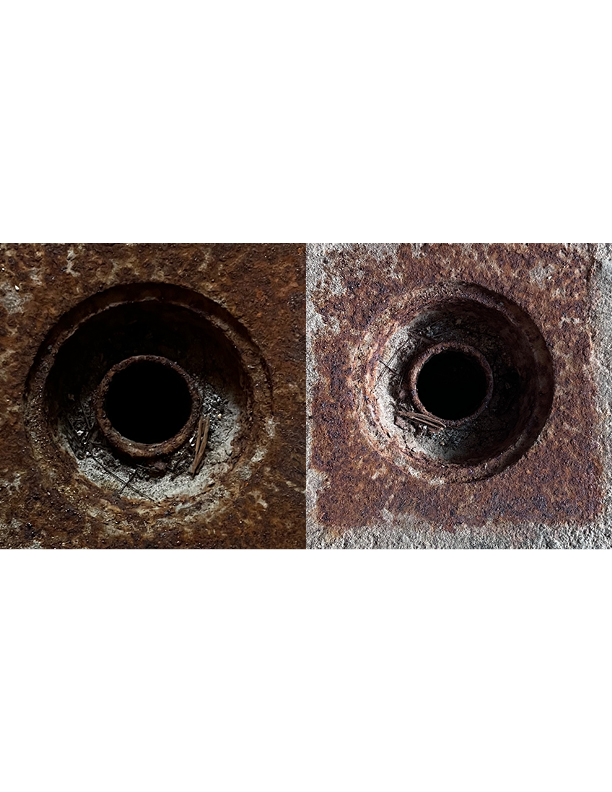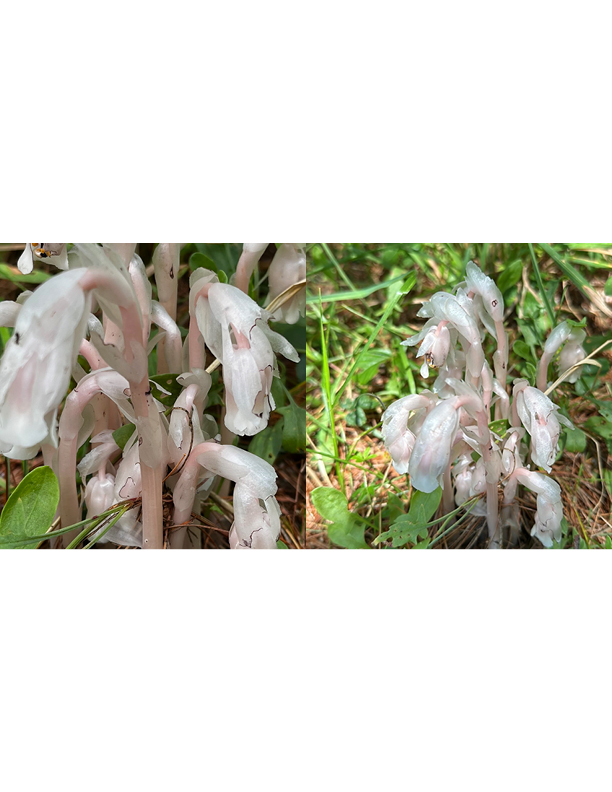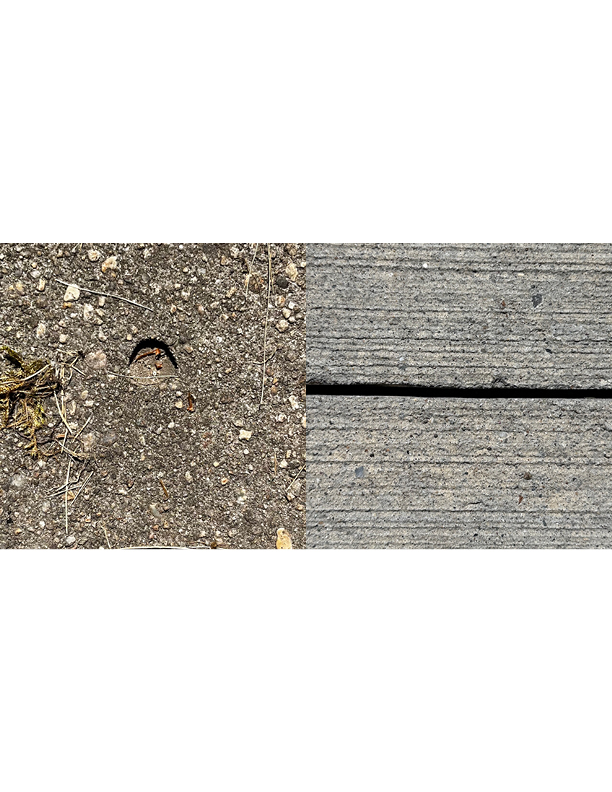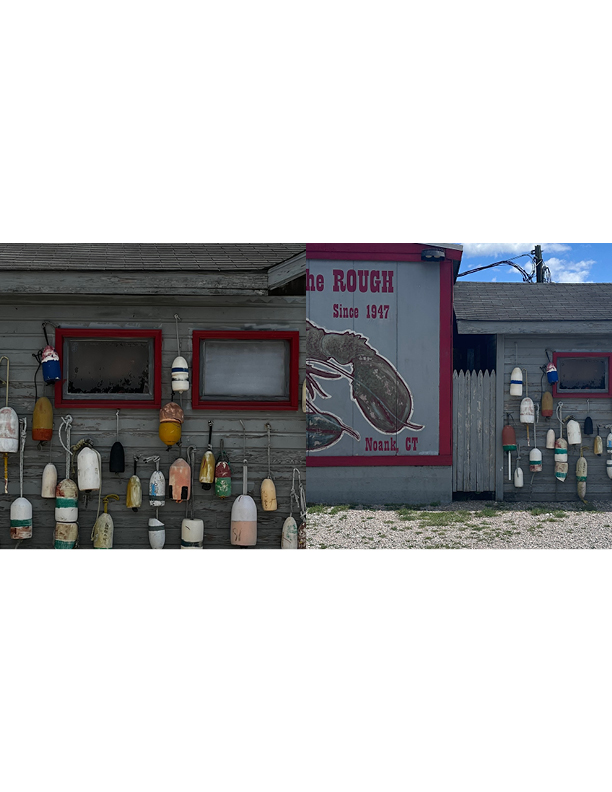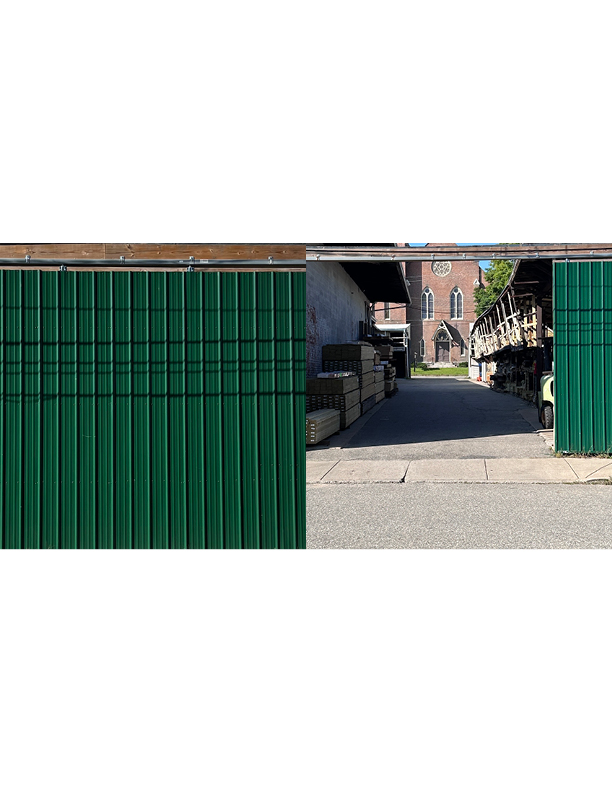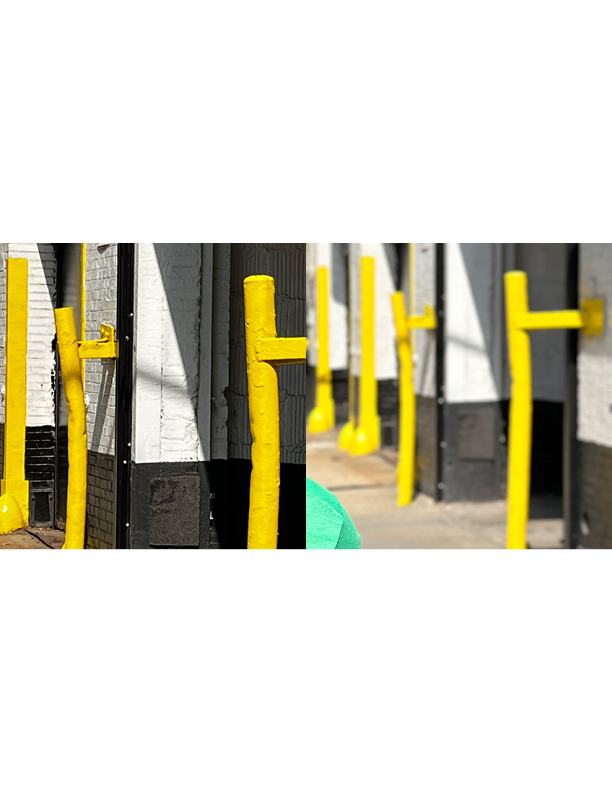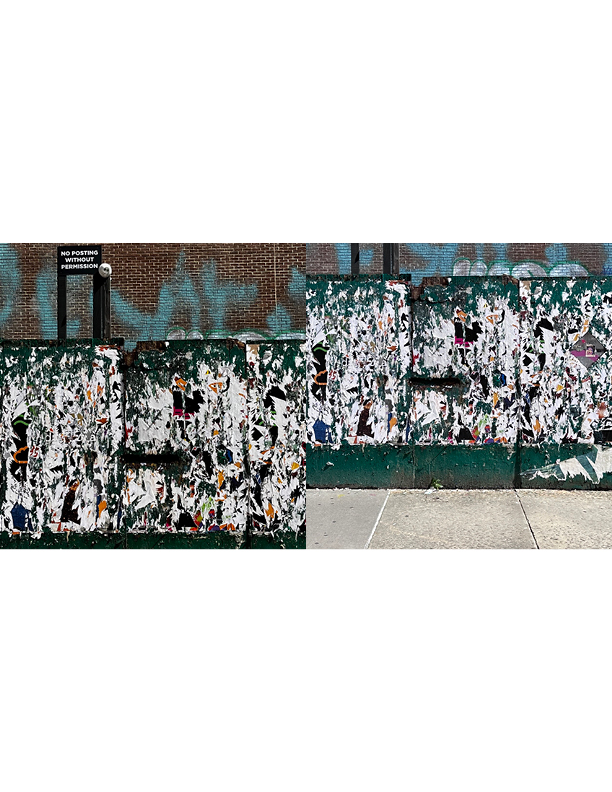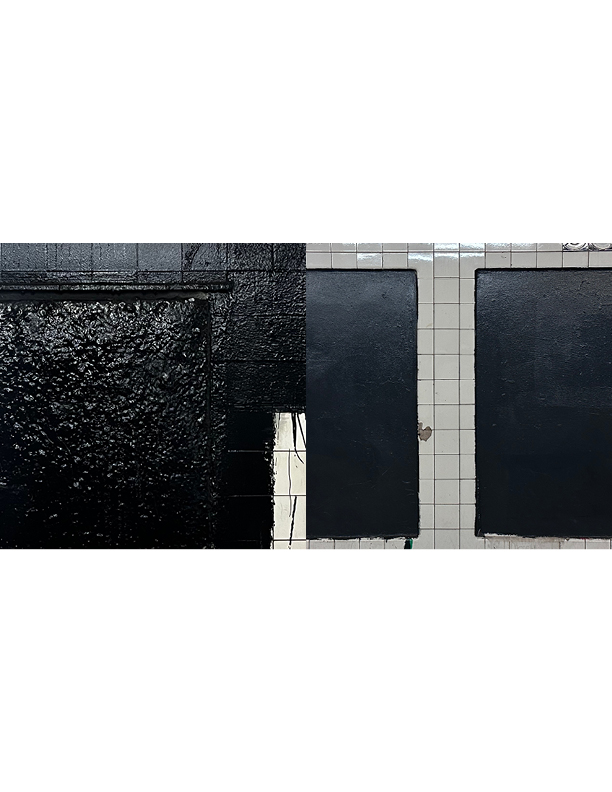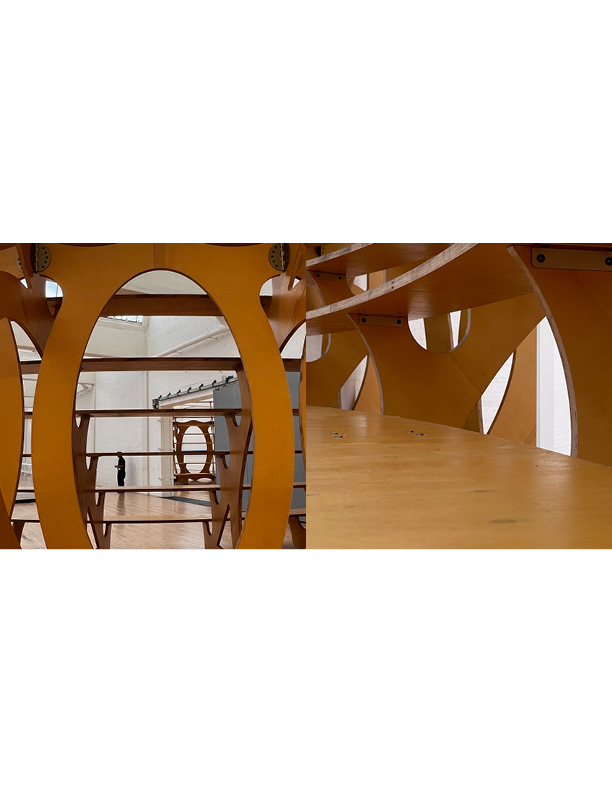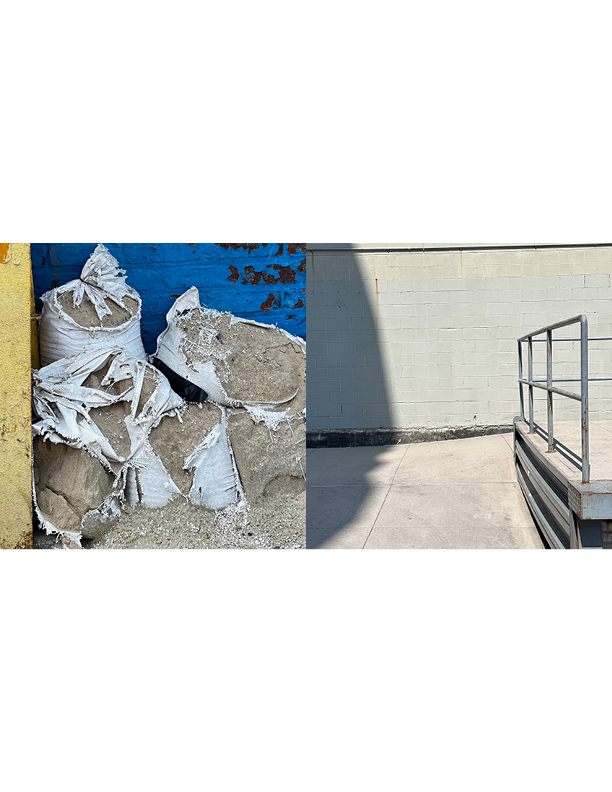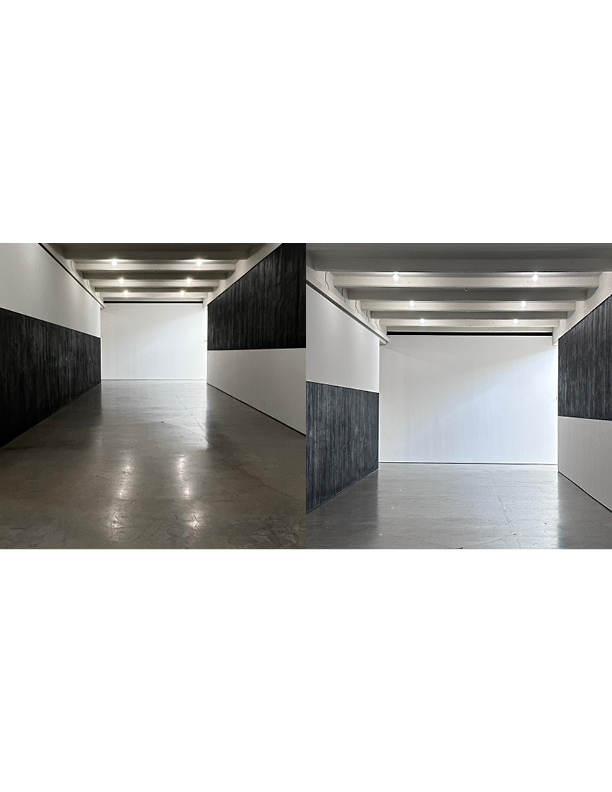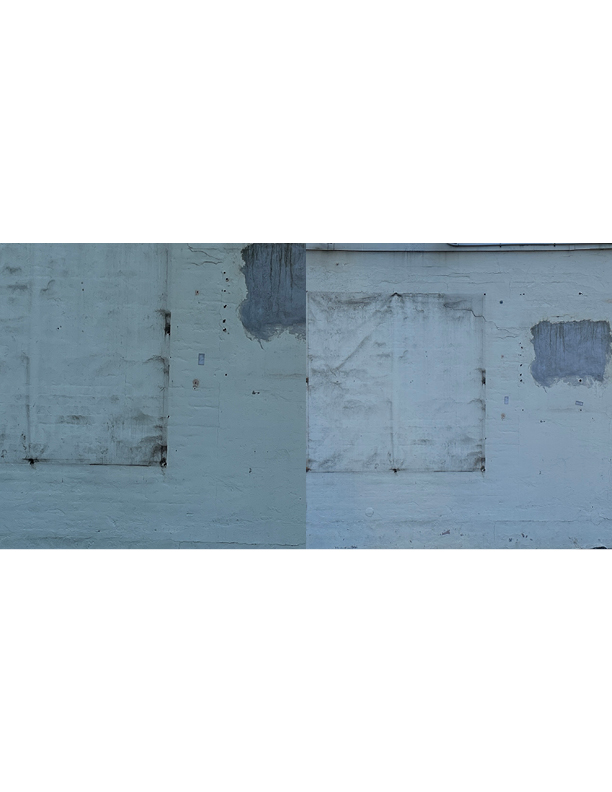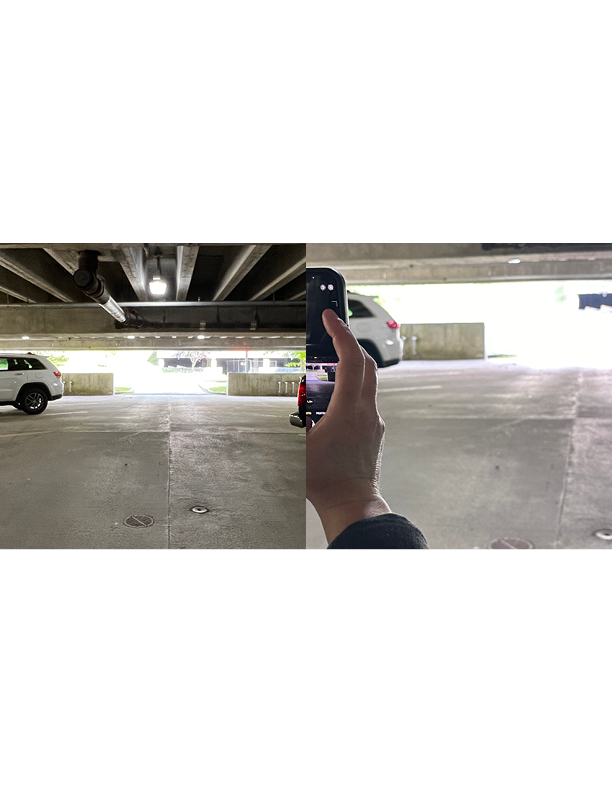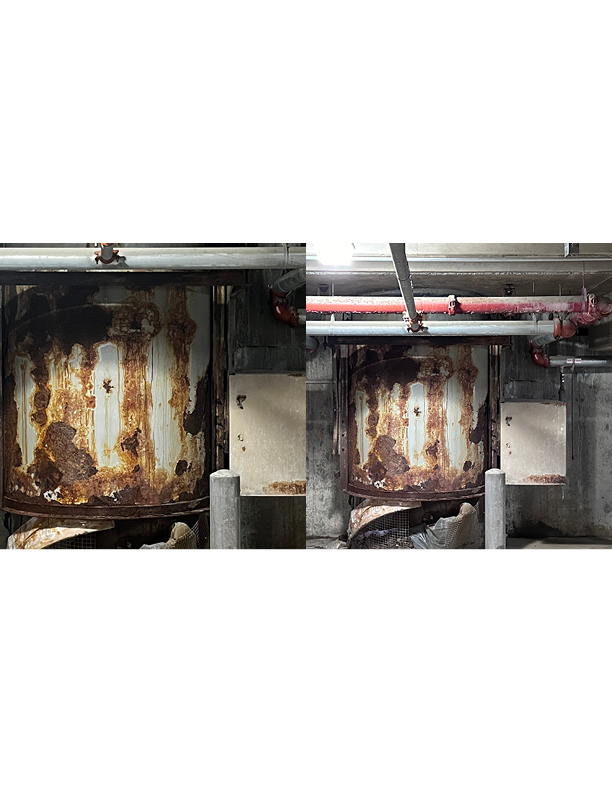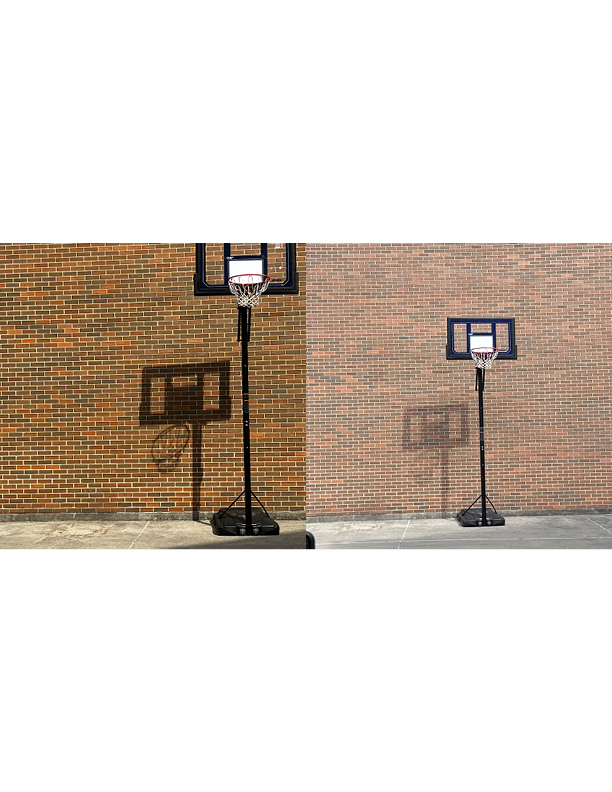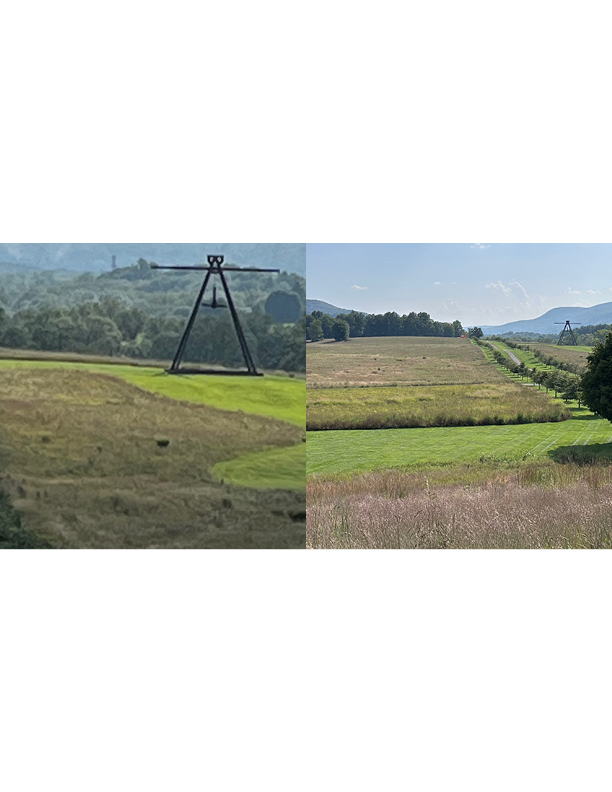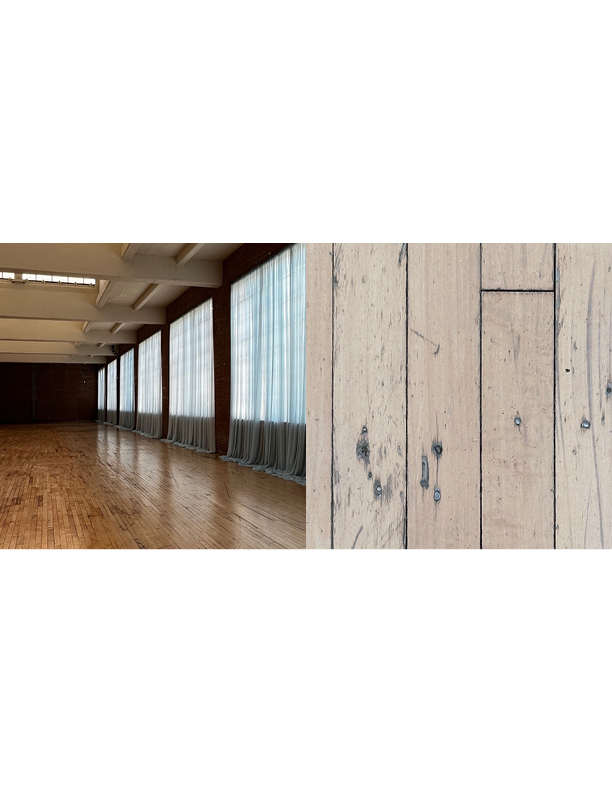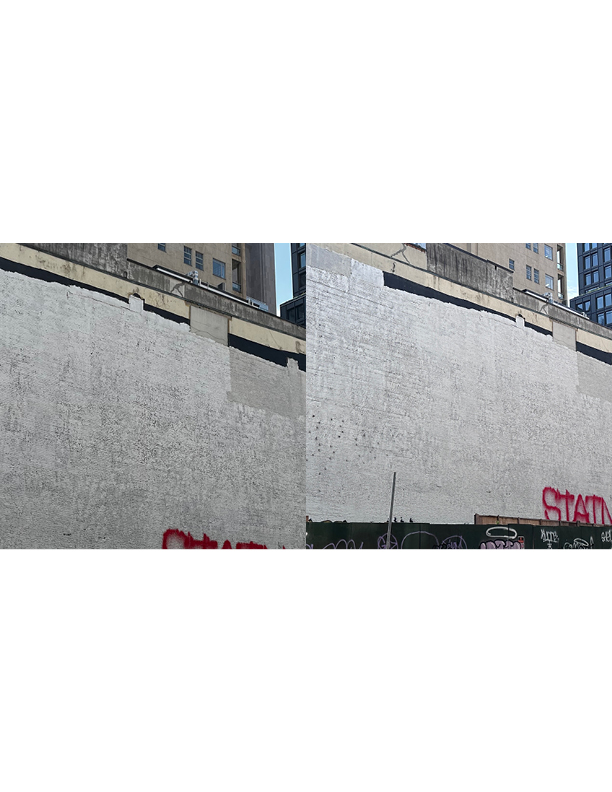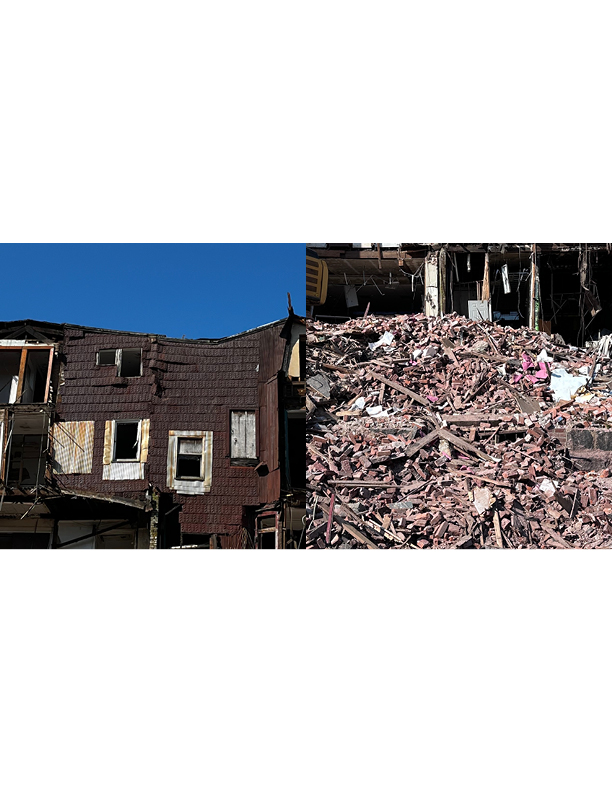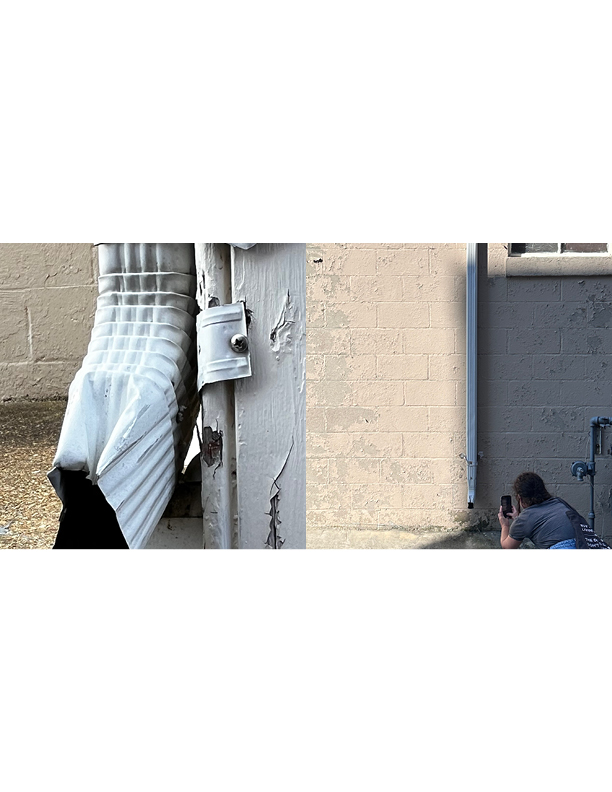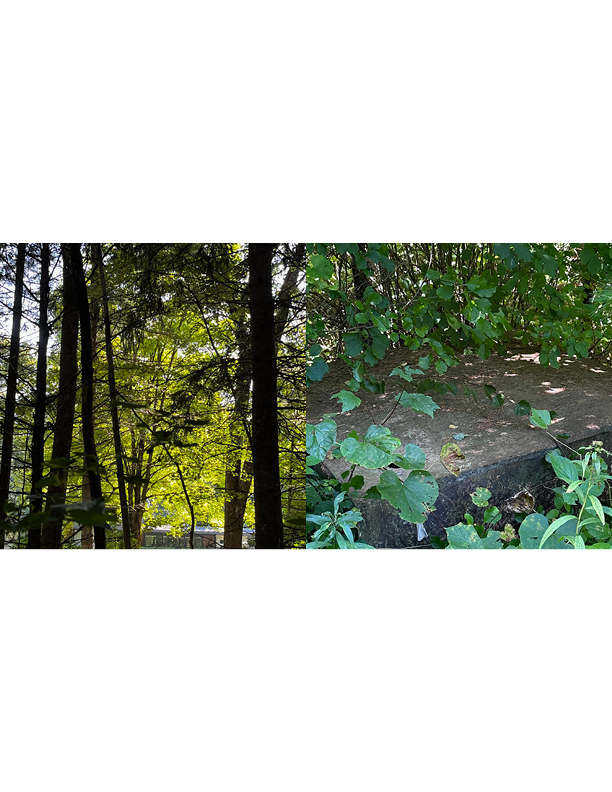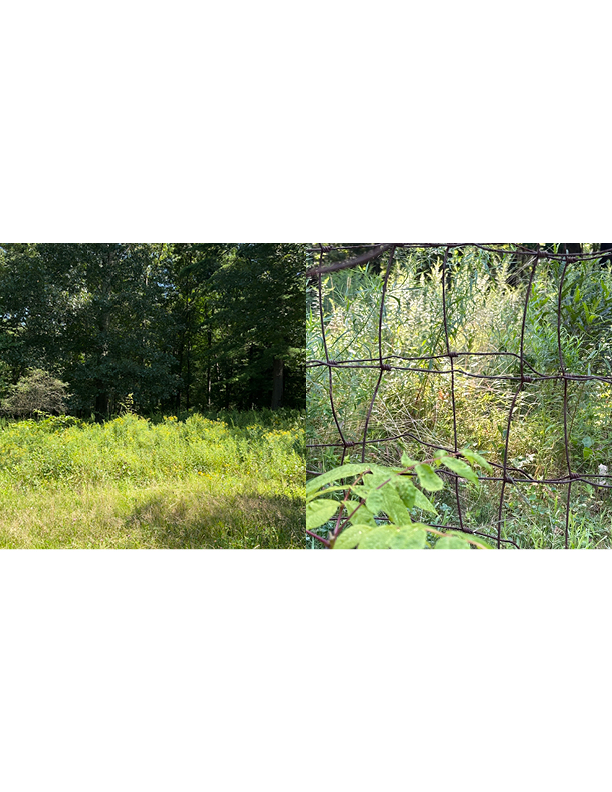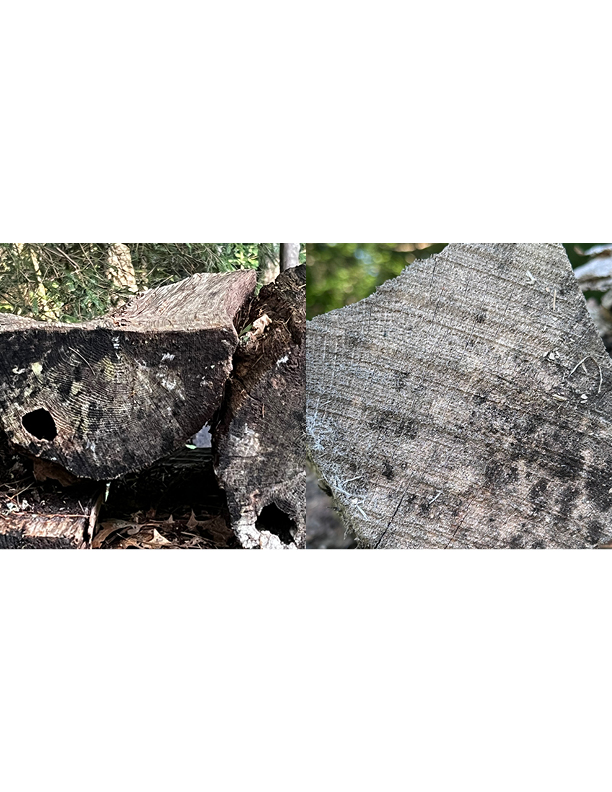October 2024
… everything is part of my practice. Inside the studio and outside. Life is my practice and my practice is life … Whether it’s artistic or not, it still goes into the great … melting pot to be used (or not) in a creative way, to be archived, or recycled into something completely different.
Tash Kahn lives in London, UK and has a studio in the Surrey woods. She has exhibited both nationally and internationally, with one project in NYC that involved dust, 3 people and a single Polaroid. Residencies are a critical part of her practice, as are collaborations with other artists. In 2014, Kahn co-founded the visual-arts project DOLPH, helping facilitate 22 exhibitions across London, NYC and Berlin, as well as partnering with two local primary schools, The Royal College of Art, and numerous artists across the world. She is also a freelance editor for Penguin Random House and Sluice Magazine.
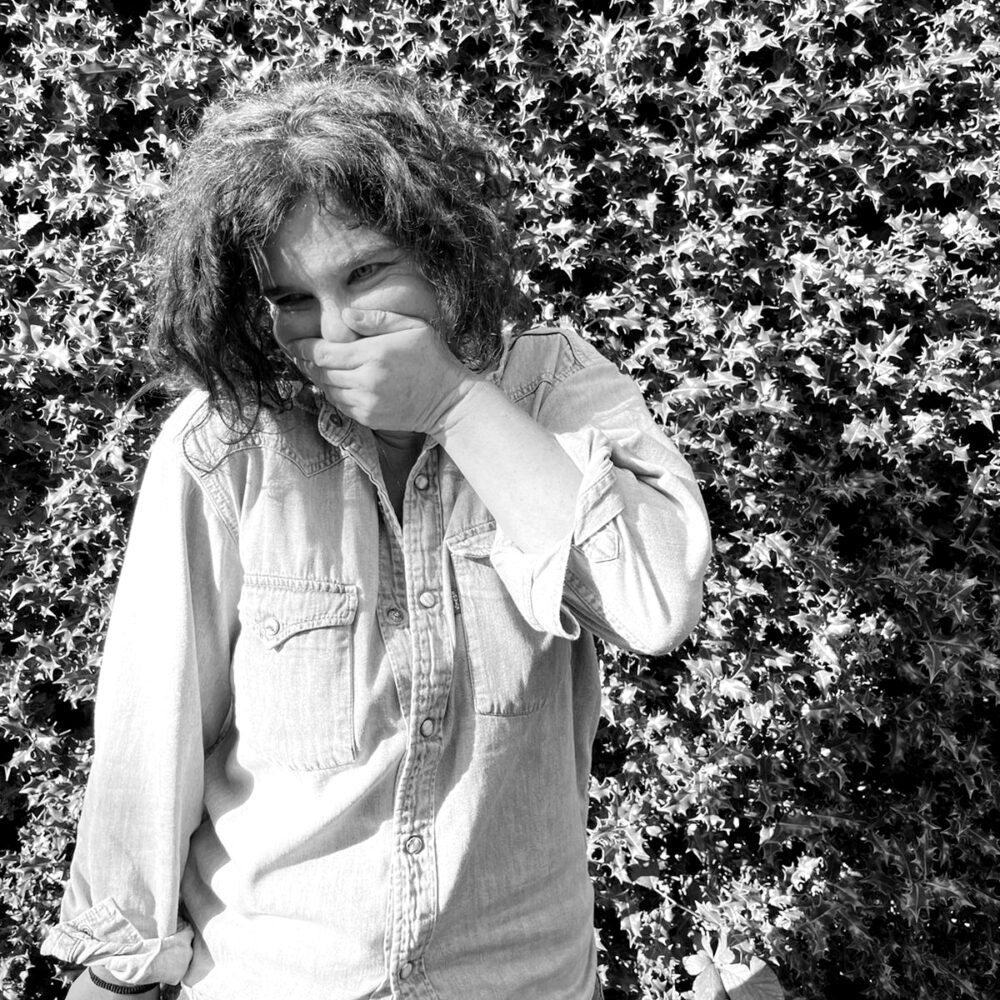
Image courtesy of the artist
john ros is a queer, non-binary, latinx installation artist with an mfa from brooklyn college, city university of new york and a bfa from the state university of new york at binghamton.
john’s multiform, conceptual practice focuses on ritual as performance, space/place, light, time and sound. they see teaching, curating and program development as extensions of their social practice, which they have implemented in a multitude of projects over the last twenty-six years.
john is the director of studioELL, a space for radical education in studio art practice and the founding director and curator of intermission museum of art. john is a lecturer in studio art at naugatuck valley community college and the school of the museum of fine art at tufts university.
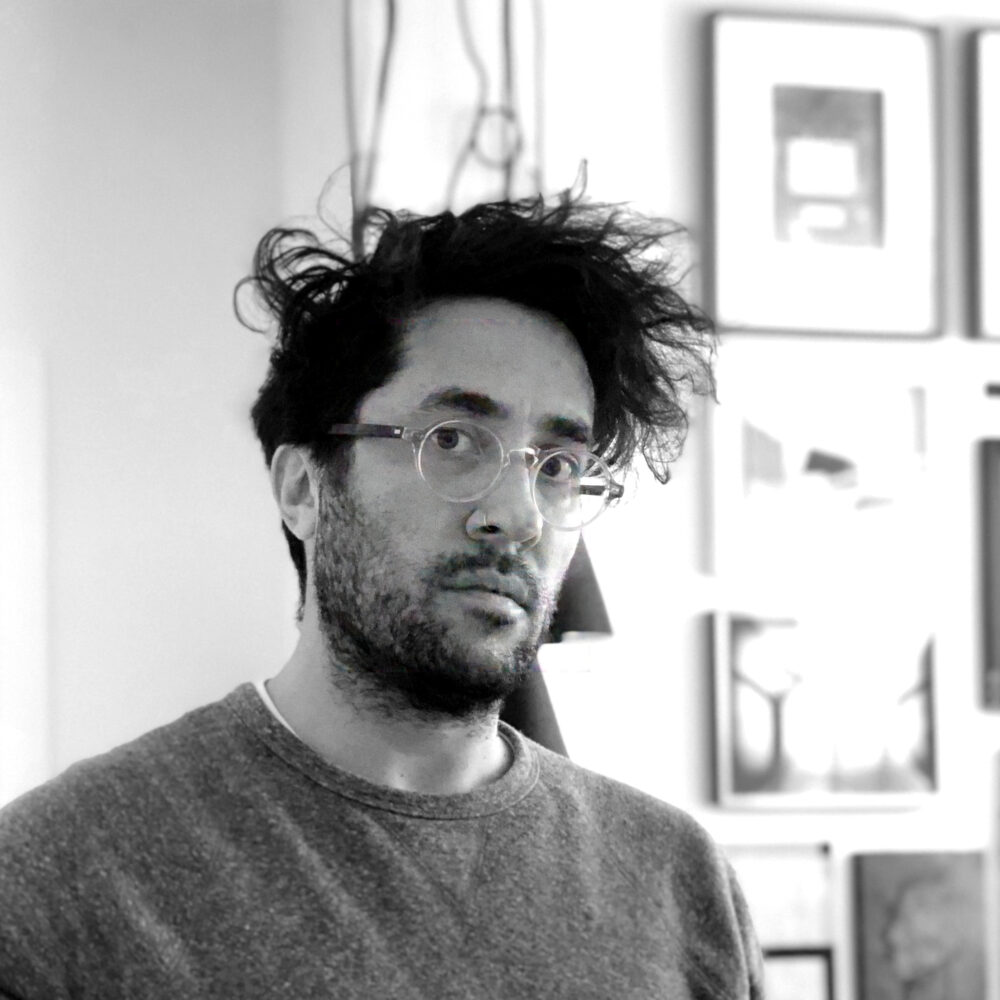
Image courtesy of the artist
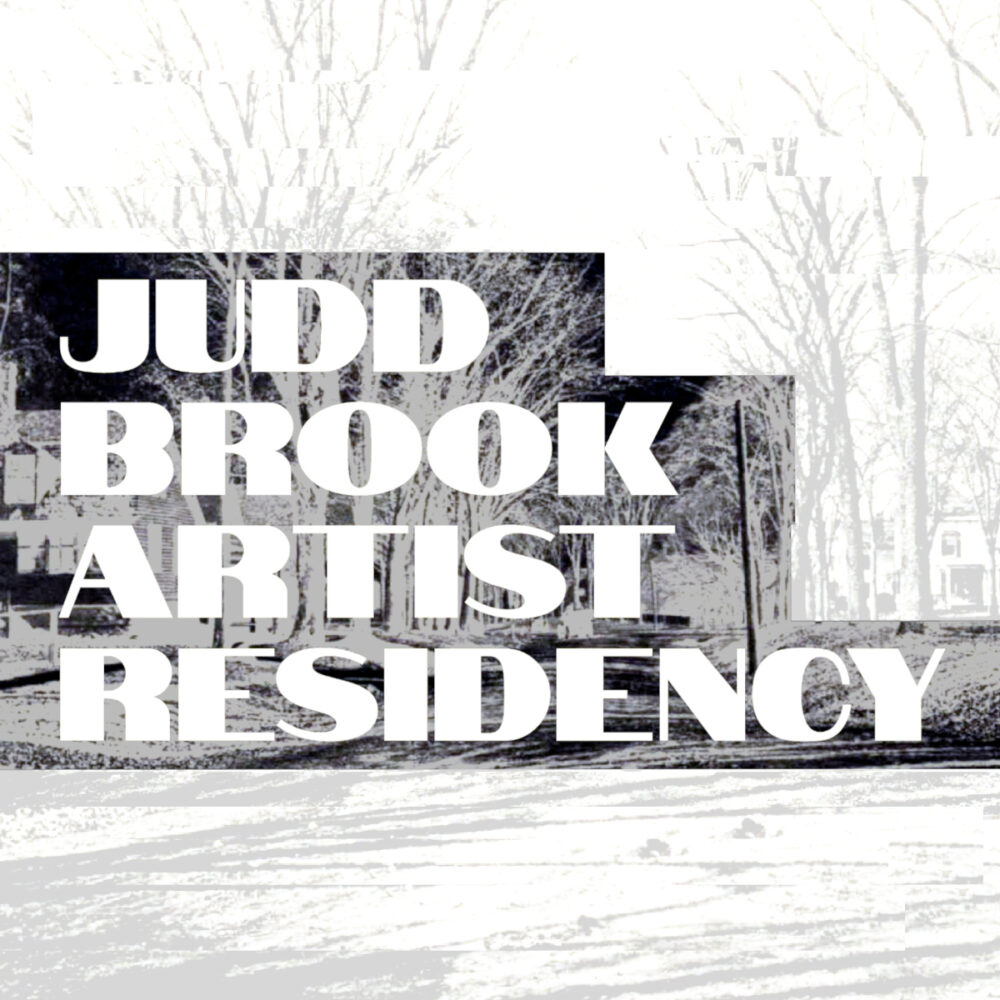
Judd Brook Artist Residency, 2024
Colchester, CT, US
Image courtesy Judd Brook Artist Residency
ARTIST STATEMENTS
Tash Kahn
My practice is multi-faceted. I work with a variety of different mediums that all bleed into each other through a process of recycling and remaking. Using painting, sculpture, Polaroids, film and collage, I document the history of everyday life by recording the debris of the present. Images are arrived at spontaneously and chance encounters are embraced through colour, composition and form. I seek out beauty in the mundane and enjoy recording the little things that others don’t notice, collecting random objects and taking numerous Polaroids along the way, ready to be archived or recycled into something else. I am interested in how people engage with art, the conversations it generates and how it makes them feel.
john ros
as a mixed media conceptual artist, i focus on creating collaborative pedagogical models that explore subtle dynamics within site-responsive interventions. by engaging with modest materials and emphasizing the unnoticed elements of a space, i aim to amplify our awareness of the world, encouraging action and agency through heightened sensitivity to our surroundings.
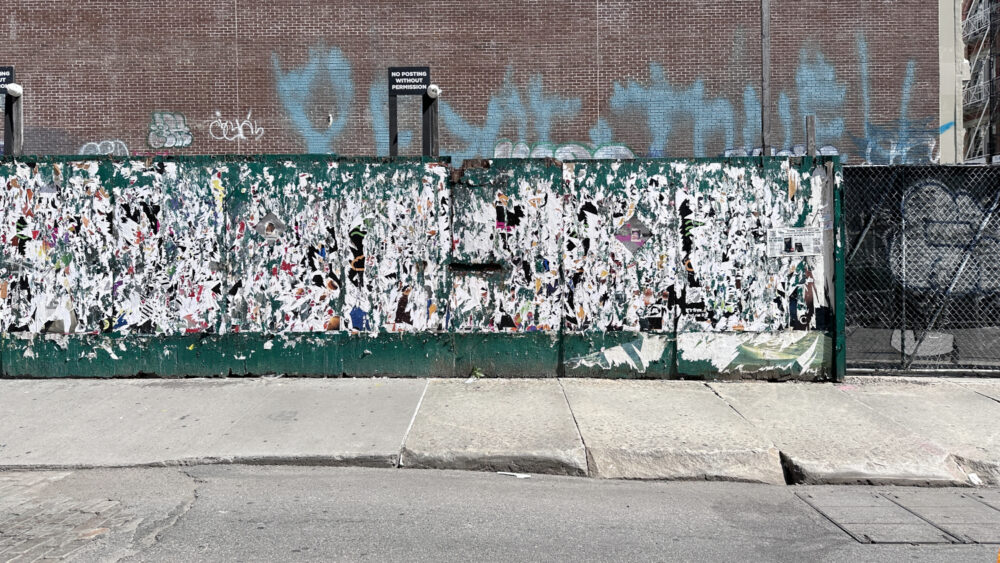
Tash Kahn + john ros
Judd Brook Artist Residency, 2024
Colchester, CT, US
Image courtesy Judd Brook Artist Residency and the artists
john ros / 22 AUG
thinking back to when we first met at sluice__ in 2015, i remember the magic of those initial connections — exploring conversations, finding common ground, and embracing challenges that helped us grow. over the years, we’ve collaborated across the atlantic and in our respective cities, and now, during this residency, we’re exploring new possibilities together. one of the biggest shifts for both of us has been our proximity to nature, in contrast with our ongoing relationships with the city. as someone who navigates these dualities — as a gemini, an introvert, and a wearer of many hats — this relationship between the natural and the human-made has become increasingly significant. how has this new connection with nature brought about the most seismic shift in your thinking, being or practice?
Tash Kahn / 23 AUG
I like that we both connected with nature at almost the same time, accidentally together. I also like that we can continue our conversation/s from this new, joint perspective.
But to answer your question – I used to think that I needed the city to glean inspiration for my practice. Its dirt and grime and straight lines gave me almost constant excitement, and around every corner there was always something interesting to catch my eye.
Then lockdown happened and I yearned for green and the country. I got my cabin in the woods around the same time my step-father died and death enveloped my life (and work) for a while. It made me peel back the layers of my practice and having the cabin provided me with the space to paint again. Painting through my grief almost, painting out my grief in a space in the woods that held it, and me. As a result, my work has become more honest and vulnerable, and real.
Now I create from an intuitive place. A quiet space that allows things in from a more spiritual realm. I think about death a lot and nature holds me in a way that the city never could. Where my work used to incorporate man-made materials and shapes – now it’s more organic. I don’t plan so much and I listen to my body more – working instead from a place that acknowledges how I’m feeling that day.
I feel more clarity and being in the woods enables this. Sometimes the noise of the city can be deafening and now I am more lucid, like everything is in technicolour. I am also getting used to just ‘being’ too. The city life is all about doing doing and the woods gave me permission to just ‘be’, to sit quietly and just watch and feel.
Some months after my step-father died I was asked to be in a show in the same area where he lived. My initial thought was to say no, as going back would be too painful, but in the end I decided that doing it might exorcise some of my grief. I sourced a local species of apple tree for an installation about my memories of him, bringing nature into my work for the first time. The tree, now planted in my garden, is an ongoing tribute to a wonderful man.
Your art is about your life and your life is about your art, and your work, ‘dia a dia buen dia’ is testament to that. What about death – how have you touched on that in your work? And how has the shift from urban to rural affected your thought process and practice?
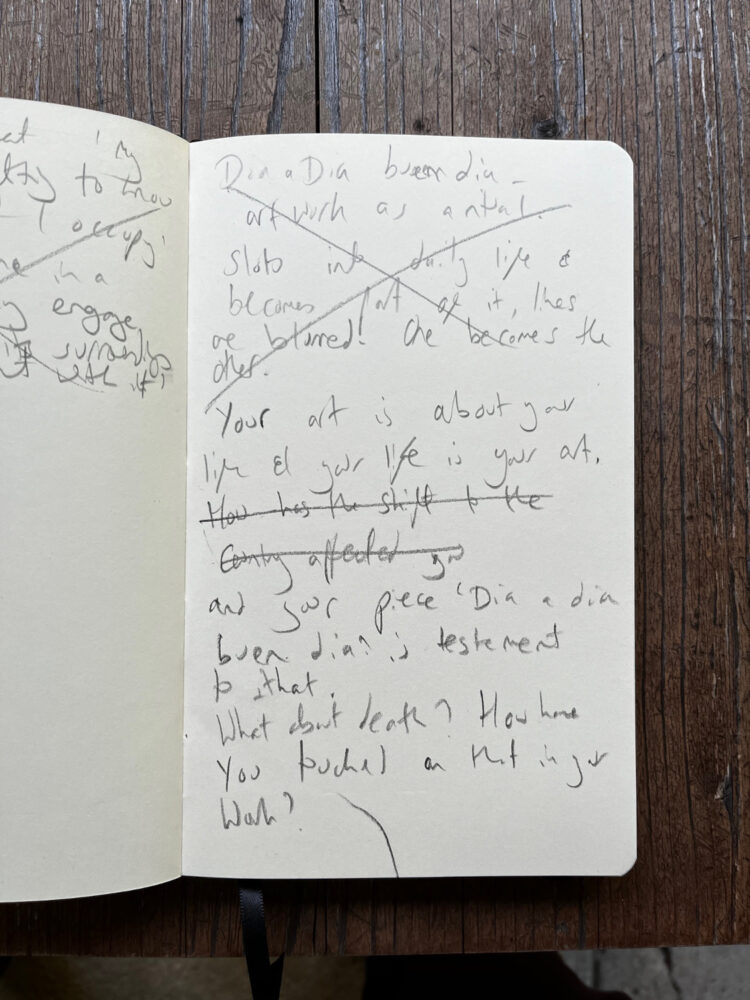
Tash Kahn, Sketchbook, 2024
Colchester, CT, US
Image courtesy Judd Brook Artist Residency and the artist
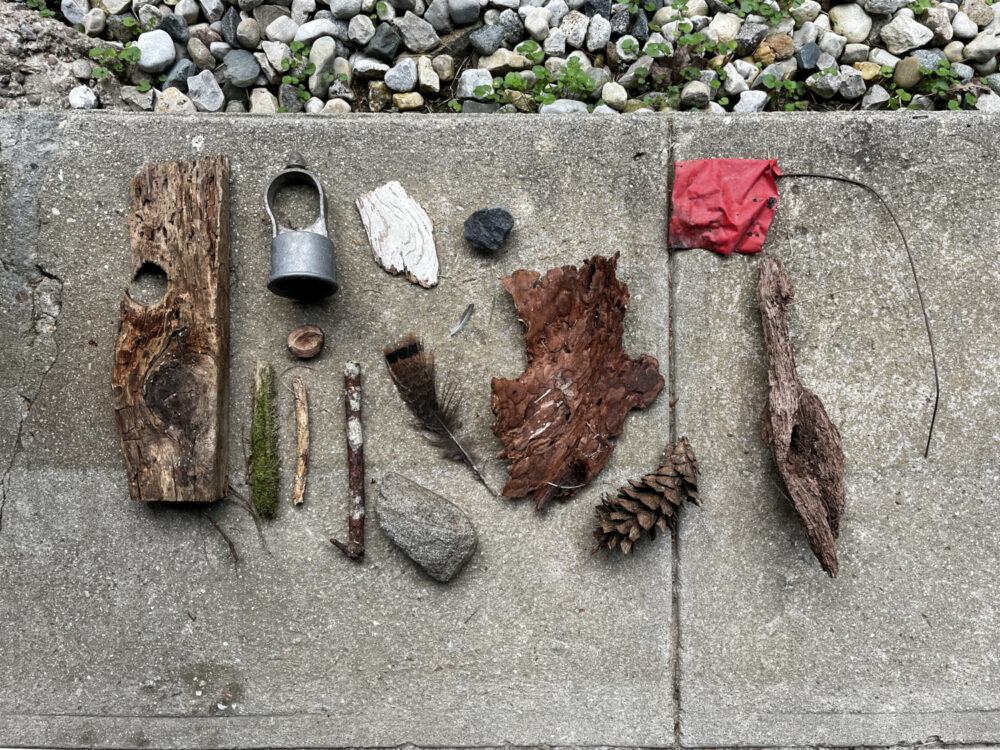
Tash Kahn + john ros
Judd Brook Artist Residency, 2024
Colchester, CT, US
Image courtesy Judd Brook Artist Residency and the artists
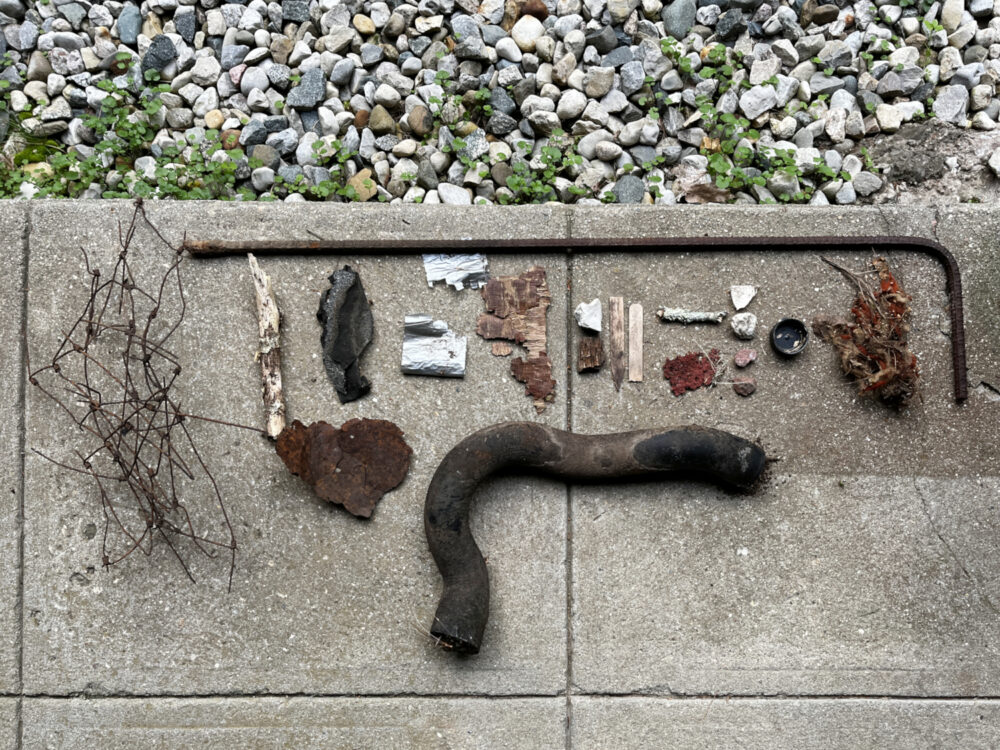
Tash Kahn + john ros
Judd Brook Artist Residency, 2024
Colchester, CT, US
Image courtesy Judd Brook Artist Residency and the artists
jr / AUG 23
i wouldn’t say i have a death wish, but i always thought i would die young. this forced me to deal with my own mortality at an early age. now that i am well beyond the point i thought i would die, there is a sense of peace in the moment. joy even. this is largely what dia a dia buen dia is about. being present in the moment. i think about john daido loori and his thoughts on what he called “american-zen”. how can i find meditative practice on line at the grocery store. but i also think about labor — labor of practice, of the home, of life. mierle ukeles obviously has had a huge impact on this way of thinking.
my first, and maybe only overt piece about death was an installation i created in 2001, sumus solem quot mentes credant, at spool mfg. (now spool contemporary art space). a visual requiem about my maternal grandparents passing a week from one another, the piece really tackled death and my own mourning of these two momentous figures in my family. funny enough, when i was removing the mounds of soil out of the gallery with my brother, he said, “i feel like a grave digger.” perfect!
since then, mortality and/or ideas of death peripherally enter thinking about systemic violence, the climate crisis and oligarchic rule [of my country]. these things are hard to shake… and they are omnipresent in everything i do. every day i exist. living between the urban and rural somehow accentuates this. the excess of the city. the calm of the country. and the complications of each of these spaces — for me, and for their inhabitants.
where do you see ideas of death or mortality going in your work now that you’ve exorcised your grief? and how has “being” heightened or softened these ideas?
TK / 23 AUG
Death cracked me open and attempting to exorcise my grief through creativity built me back up again, albeit in a different way. I wouldn’t say I’m completely done though. Grief has a way of getting under your skin over and over again, you just get better at handling it. Now I am less scared of being vulnerable and honest, and worry less about what others think.
My mother was an artist and when she died in 2013 I inherited some of her work. Some pieces I love; some not so much. Recently I had a big clear out of my own paintings, slashing old canvases and painting over others. One of my mother’s stood out, I didn’t like it very much and wondered if I could dare throw it away, instead I ‘collaborated’ with her to create something new. I started out matching colours to her marks, gingerly going forward as if I was scared to lose her almost. Then I heard her clearly saying ‘don’t be scared, slap it on!’ I ended up painting with her and I hope to do it again with some of her other works.
When my step-father died we scattered most of his ashes in the woods behind the cabin. I had an incredibly clear vision of keeping some of the ashes behind to mix into paint. I wanted to paint his favourite phrase onto a board using garish cadmium red and cobalt blue, and that he was part of the paint made it all the more raw.
‘Being’ has made me live in the moment, knowing that everything could end at any time.
Your installation, sumus solem quot mentes credant is wonderful and deeply personal. Tell me more about it – how are the individual parts significant and if you had to do it today would you change anything?
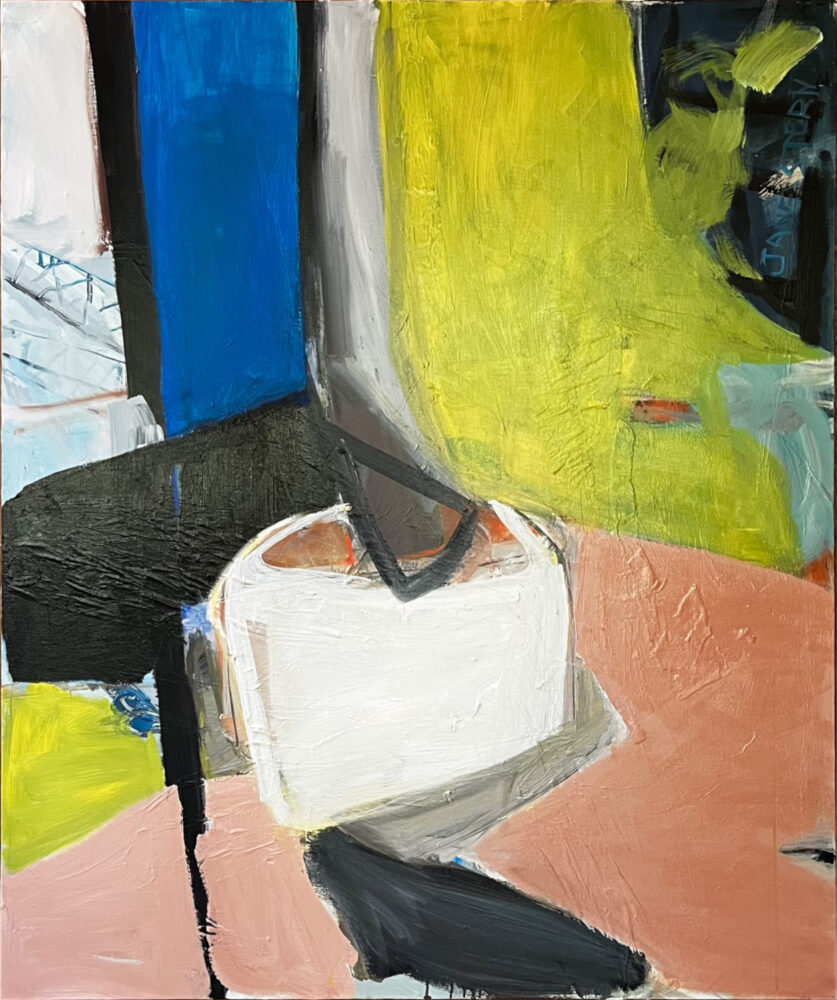
Tash Kahn, Untitled, 2024
Colchester, CT, US
Image courtesy of the artist
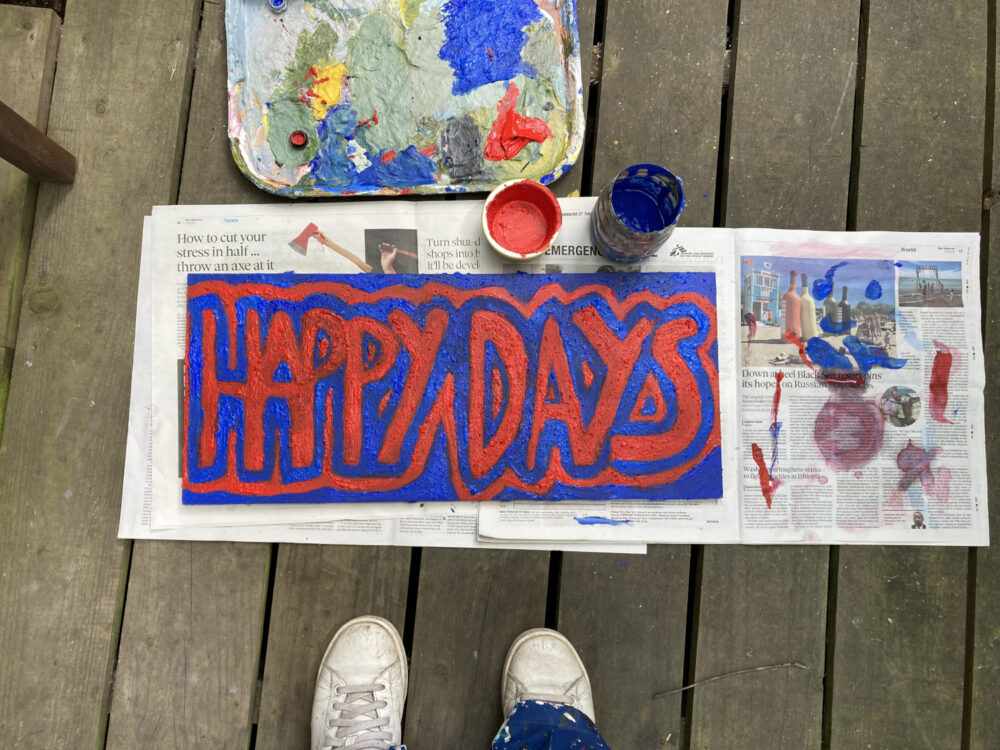
Tash Kahn, Happy Days, 2024
Colchester, CT, US
Image courtesy of the artist
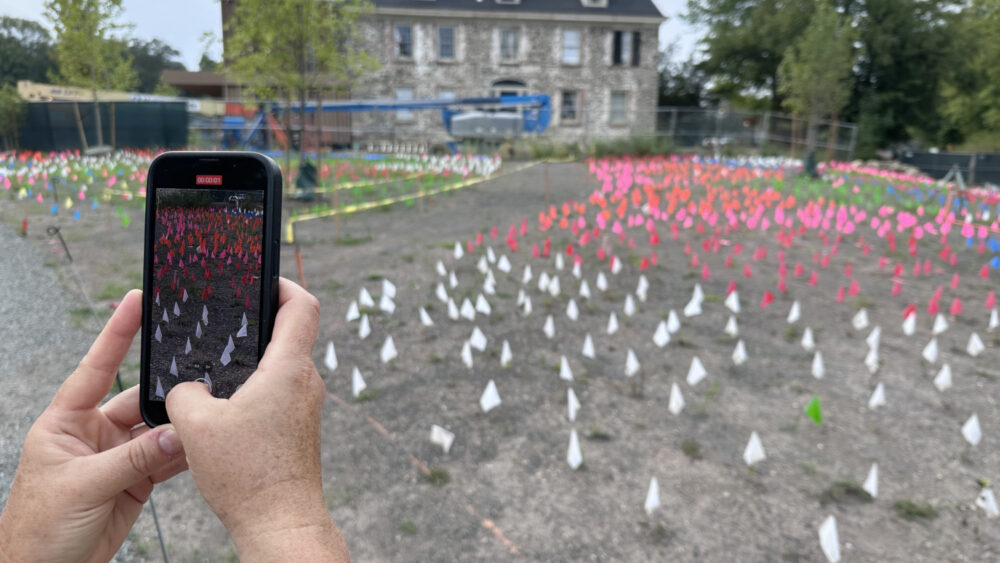
Tash Kahn + john ros
Judd Brook Artist Residency, 2024
Colchester, CT, US
Image courtesy Judd Brook Artist Residency and the artists
jr / 23 AUG
i suppose a visual requiem is quite personal. at the time i was installing, i also lost a dear friend of mine, angelo ippolito. he was in the hospital a block away from the art space. his proximity (to me) and his passing seemed to bring my grandparents’ deaths closer to me in a very tangible way.
the major parts were a series of reflected black pieces, mounds of dirt, drawings and mixed media 2d work, and sculptural work.
mirroring and reflection played an important role. perhaps looking at lineage — and life cycles as a way of passing along familial knowledge, identity and being.
scent became an important part of the piece with the drying soil filling the air and the subsequent dust falling throughout the space. there was a cyclical poetry at play. the monotypes with charcoal also touched on this maybe less directly. i remember listening to mozart’s requiem over and over building these pieces (hung on the back wall).
finally, the vessels of yellow talked to resilience. they were filled with urine and cadmium yellow pigment. these represented the strength the human body, even in death. both my grandparents were ill and in the hospital. i got a call one night and we were all expecting the news about my grandmothers passing because she was more frail, but it was my grandfather who passed first. my grandmother continued for an additional week, peeing on her final day, even though fluids and support had been cut off. it seemed impossible, but the body kept fighting and functioning as best it could til the last moment.
would i change anything today? … hmm… this is a difficult question. my answer to the question, “do you have a favorite work you’ve done?” is always, “the most recent and the next.” i somehow think this way of thinking comes into play here because in many ways i feel like the pieces would be entirely different if made today. also, to be fair, i’ve already had a chance to work with these materials (especially soil), so i doubt it would be made in a similar manner. but i don’t know.
thinking about the deeply personal — how much do you think is important to reveal when making work. or to put it differently, how much do you like revealed to you as a viewer of artwork? what does that choreography look like in practice and when is it time to protect yourself? is there a difference between being vulnerable and revealing too much in the work?
TK / 27 AUG
I think it’s up to the artist as to how they reveal/how much/whether they do it at all. I personally think my work is more ‘real’ since I decided to reveal parts of my life that I once kept hidden.
Years back I made paintings of construction-site hoardings that bisected the canvas with a flat plain of colour. I remember having a crit with an artist who said that the graphic line ‘didn’t allow people in’ and that if I was going to be taken seriously I needed to be more generous. At the time, the thought of getting deeply personal was an anathema to me and I hated the thought of others ‘knowing’ me through my work. I would purposely keep the titles ambiguous and ask the viewer to make their own minds up.
Now, however, it’s completely different and I think my work is better if there is honesty and vulnerability in it. Maybe there’s a little bit of ‘art as therapy’ going on there too. But as a viewer – do I want to know everything? Sometimes I do, yes. I suppose it depends on whether the artist wants their work to be interpreted exactly the way that they want it interpreted or whether they let the viewer make up their own minds. I think the art world suffers from too much hand-holding and as an artist, I loathe the way we have to explain everything. BUT as a viewer I always want to know more. HA.
In terms of protecting myself and revealing too much – as long as I enjoy what I’m doing that’s good enough.
Whatever you put out there, people will interpret it in their own way though, regardless of how much we reveal and explain. I think it boils down to how much do we as artists care about what the viewer thinks, what kind of art do we want to look at, what kind of art do we want to make, and for some, what kind of art will sell. What are your thoughts?
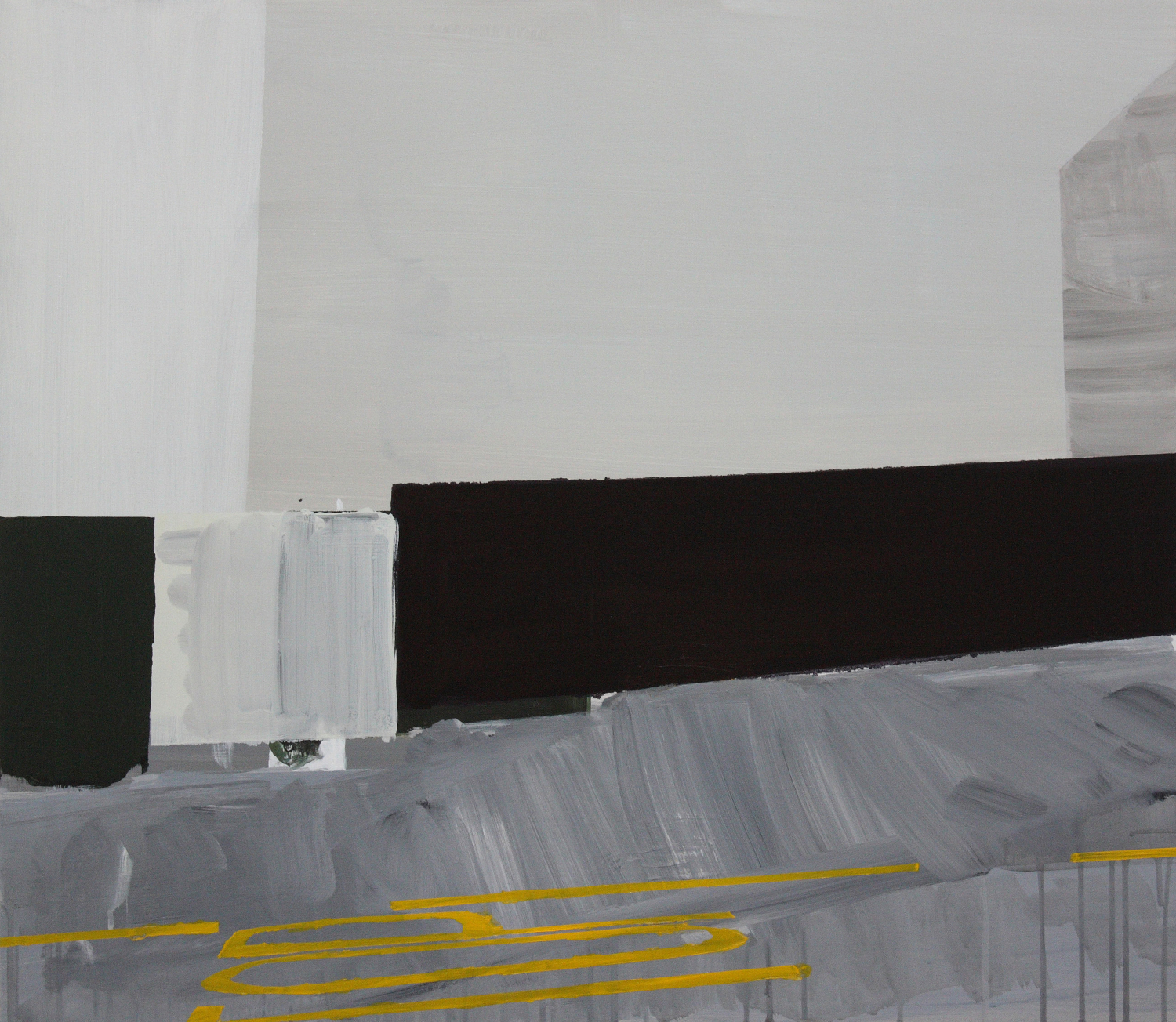
Tash Kahn, Waiting, 2008
Colchester, CT, US
Image courtesy of the artist
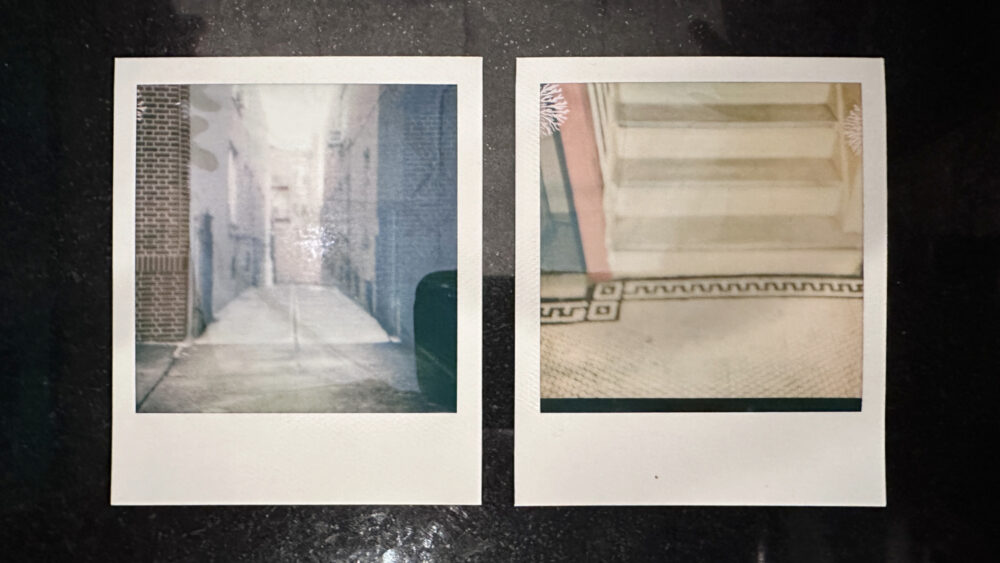
Tash Kahn + john ros
Judd Brook Artist Residency, 2024
Colchester, CT, US
Image courtesy Judd Brook Artist Residency and the artists
jr / 28 AUG
how we engage with the visual is so interesting and complex. we live in a visual world followed by and following screens for hours — bombarded by the visual — consuming it to no end — on the tv, the screens in restaurants and train stations, airports, gas stations and taxis and … . yet we often don’t seem to be visually literate — understanding the visual language presented beyond the obligatory “ask” … buy this… click here… heart… repost… . in many ways we don’t trust ourselves to decipher visual language, or maybe we feel like we haven’t been given permission to translate for ourselves. but also, the gatekeepers are good at guarding this language, emphasizing higher degrees or pushing finish lines further away, or changing the rules mid-game. social media changed this alot. artists used to be better at controlling visuals, but more and more we’ve relinquished this power to the few — the corporations benefitting from our work through obscure algorithms. they no longer have to come to us. instead, we are crowded up waiting for the minuscule crumbs to fall. this all complicates our relationship with the visual and how visual language is consumed from the simple to the most complex.
visual language is predominantly that — visual. complexities arise when the conceptual comes into play, but also specific research or intent may or may not always be understood by the visual alone. i think that is ok. however, once something it presented to the world, it must have a life of its own. some like to control this from beyond the studio. i like to let things breathe on their own. regardless of layers of the personal or political that are embedded in my own work, the work must tell the story. i am always happy to go further during a conversation or a lecture, but i refrain from giving too much information initially. perhaps i respect the audience too much and want to give them agency in how they view a work.
as a regular consumer of the visual, i like to be challenged. i don’t want to know everything. i want to translate and decipher and learn about the visual from the visual. this takes time and is alot of work. but it’s more rewarding. i will always research after, but engagement with the visual is first and foremost for me.
i’m interested in the contradiction you presented. “I loathe the way we have to explain everything. BUT as a viewer I always want to know more.” i think this also comes down to the impossible tasks asked of artists today. we must be our own producers, managers, assistants, curators, marking agents, copy writers, web designers, social media content creators, etc. i have two questions. firstly, contradiction — a truth beyond truths that can at times feel wishy-washy at best. how do you play within the book ends of contradiction? secondly, how have you managed all the roles associated with being an artist along with also being a human, a friend, a community member, a mother, etc.?
TK / 29 AUG
How do I play within the boundaries of contradiction? If I’m honest I struggle. My life is an ongoing battle of staying in my comfort zone vs getting out of it and leaning into my triggers. Why change something if it works vs why stay in the same old rut? This constant opposition is difficult mentally.
The notions of selling out vs integrity are also ever-present in my practice – I want to make money from my art but the inaccessible stuff is not so easy to sell and I don’t find any joy in making art that plays to the public. Hand-holding vs letting the viewer interpret the work themselves is another one. Ditto showing vulnerability vs keeping cards closer to my chest. Ultimately though, I think it depends on what mood I’m in as to which way I go, the work also has a say in the end result, there is no right or wrong.
To answer your second question – I multitask to within an inch of my life. I used to compare myself to Worzel Gummidge, the scarecrow in the British 70s tv show who had a different head for every situation, a singing head; a party head; an arithmetic head… I have a mother head, an artist head and an editor head etc, and they all fit comfortably into my life. Of course things get confused, but through this confusion, I am always making art and that seems to slot into everywhere comfortably. Like you, my life is my practice and on that note – do you ever/how do you ever draw the line? Are there some things that will never become part of your practice for one reason or another?
(PS I realise that I answered those questions in a contradictory manner!)
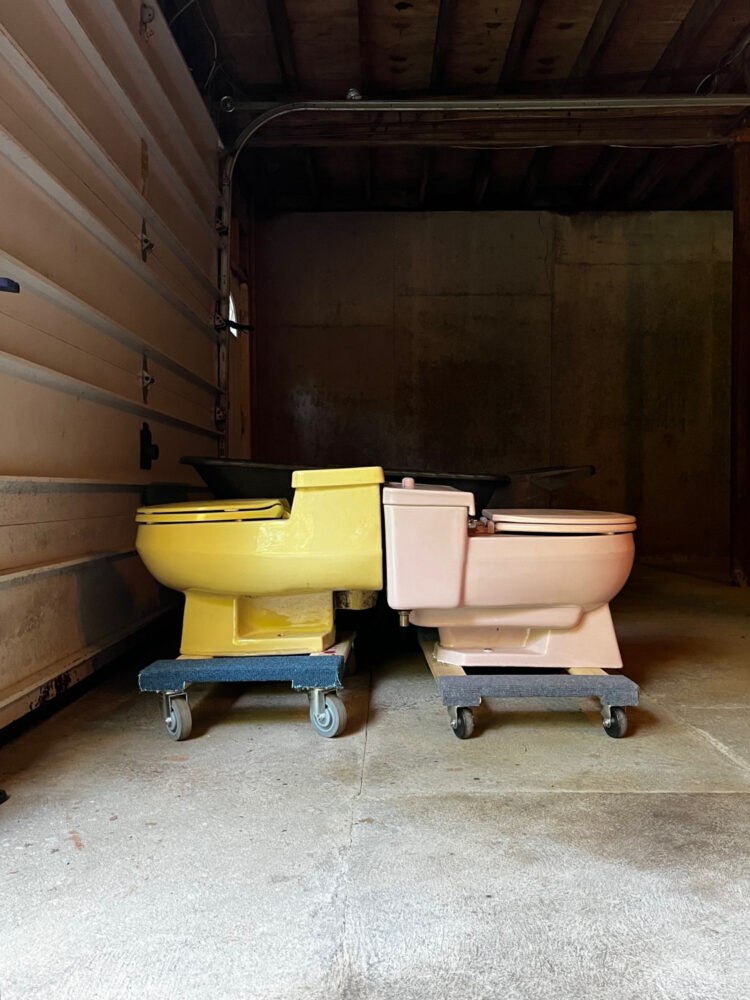
Tash Kahn + john ros
Judd Brook Artist Residency, 2024
Colchester, CT, US
Image courtesy Judd Brook Artist Residency and the artists
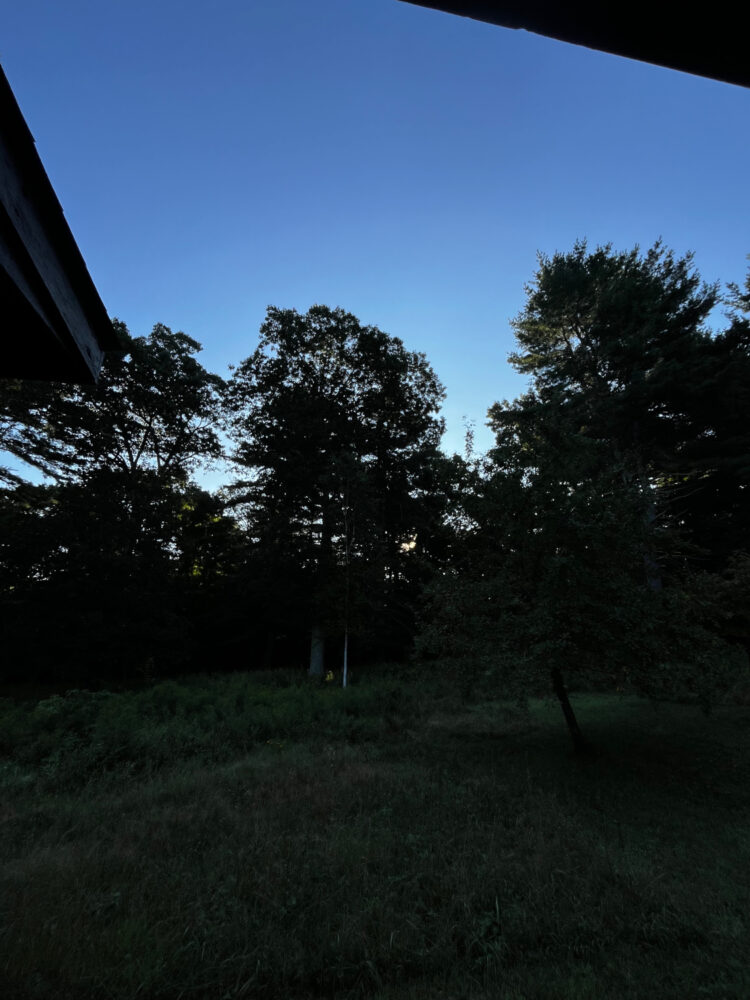
jr / 30 AUG
drawing a line is important. but even though a line may be drawn, the work is still part of practice — just maybe kept closer to the chest. for instance, i work within the academy, but due to the part time nature, i work at multiple institutions at once. this makes it harder to focus, but easier to compartmentalize. so, email is not on my phone or my computer. i choose to login into webmail which keeps it at a distance. i limit my hours of engagement to the days i teach at each institution as a way of maintaining space. this doesn’t prevent me from thinking about classes or students or lectures with this separation, it just creates more space for me (and my practice) to be — while practicing distance.
i also don’t include the specific meals i cook in día a día buen día, but cooking is a major component to practice. likewise, specific chores are not denoted, nor are distractions within each indoor or outdoor chore. i choose to keep some of these specifics out of the day by day writings, but it doesn’t make them any less important.
i don’t mention when i shit or piss or cum or have sex or dream or have panic attacks or excessive stress or anxiety or when i take my pills or play with, feed or groom my cat … i don’t always mention specific people i visit with or exhibits i experience or readings or viewings or listenings or the specifics of other experiences, but again, these are all important parts of the day. they fold into my energy and the energy of the day. they sit in space, with me. living, practicing, breathing.
lines are important. space is important. time is important. we often get to choose how we exist within these elements — opening possibility.
what is the least artistic thing you’ve done recently that you considered part of your practice. and what was the most artistic/creative thing you’ve done that you may not have considered part of your practice?
TK / 02 SEP
I love those questions and I might answer exercise to both, specifically swimming. I started cold-water swimming last December – 10 years to the day that my mother died – and it was like a rebirth. I don’t immediately think of it as artistic, but as soon as I get into the water my anxiety dissolves, leaving behind a profound sense of peace and revealing a space perfect for creativity. Without it, I couldn’t continue my practice. Exercise as a whole is also a great enabler, it enables me to get out of my head and into my body – something that I try and do every minute of every day. Once you get into that ‘zone’ you can do anything.
However (and to continue along the contradiction theme), I think exercise in all forms is creative – in swimming especially, the way I move through the water, streamlined and fluid, is art personified – yet I don’t consider it part of my practice.
Quite possibly though, like you, everything is part of my practice. Inside the studio and outside. Life is my practice and my practice is life, just like your art is about your life and your life is about your art. Whether it’s artistic or not, it still goes into the great john/Tash melting pot to be used (or not) in a creative way, to be archived, or recycled into something completely different. That’s our lives as artists right there. And maybe that’s why we get on so well.
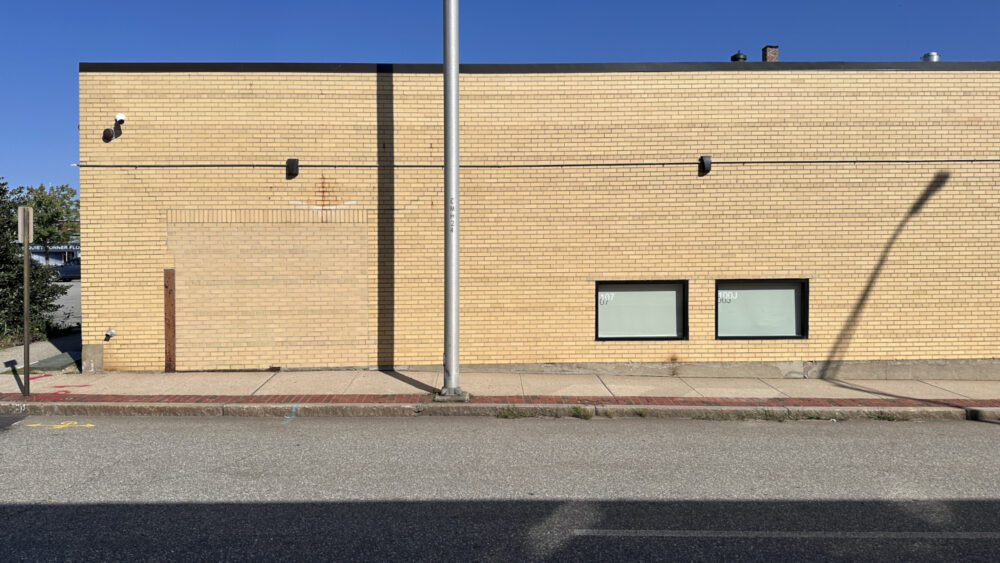
Tash Kahn + john ros
Judd Brook Artist Residency, 2024
Colchester, CT, US
Image courtesy Judd Brook Artist Residency and the artists
Tash Kahn + john ros
Parallax, 2024
Judd Brook Artist Residency Colchester, CT, US
Images courtesy Judd Brook Artist Residency and the artists
dowload .pdf
THE SIX …
Six questions asked of all our guests.
Tash Kahn
What are you currently reading?
I am terrible with books. I start them, get really into them and then get distracted. Invariably at that point, I buy another one and the cycle starts again. I have to say though, I did read (and finish) and really love, ‘Why We Swim’ by Bonnie Tsui. A beautiful meditation of a book on our connection to water.
What are you currently watching?
Slow Horses is hilarious and brilliant, and I love love Gary Oldman.
What was the last meal you made?
Pho, Vietnamese noodle soup with lots of chilli.
Can you share a recipe?
Cold chicken with spicy Sichuanese sauce
300-350g Cold, cooked chicken (although I sometimes have it hot)
3 spring onions
1/4 tsp salt
1 tbsp sesame seeds
Rice to serve
For the sauce:
2 tbsp soy sauce
1 1/2 tsp Chinkiang vinegar
1 1/2 tsp caster sugar
1 tbsp chicken stock
3-4 tbsp chilli oil
1/2 tsp roasted, crushed Sichuan peppercorns
1 tsp sesame oil
Tear the chicken into strips and put into a deep bowl. Cut the spring onions into thin slices and add to the chicken together with the salt. Mix.
Toast the sesame seeds and set aside. Combine all the sauce ingredients and pour over the top of the chicken. Sprinkle with sesame seeds and eat with rice, it’s delicious.
Whose studio have you visited recently that really excited you?
It sounds awful but probably my own. I have a cabin-cum-studio deep in the woods and it’s a blissfully quiet space.
What have you seen recently (either art; performance; film, music; stage; etc.) that had a significant impact on you and your work?
Marina Abramović at the Royal Academy was epic and made me look at my practice, and indeed – my life – in a whole new light.
john ros
What are you currently reading?
like tash, i also pick up a bunch of stuff… and read a bit, a few paragraphs, a chapter, an essay, etc… then leave it for a while, usually from distraction. it also takes me very long to read for comprehention… one of the joys of dyslexia. i have endless piles of unread books in the office, studio and bedside table.
i am currently trying to tackle:
Creativity Exercises : Emancipatory Pedagogies in Art and Beyond, edited by Dóra Hegyi
László Moholy-Nagy: From Material to Architecture. Edited by Lars Müller
We Wanted a Revolution : Black Radical Women, 1965-85 , edited by Catherine Morris
Landlord Colors : On Art, Economy, and Materiality by Laura Mott
Pope. L : Campaign. by Pope L
What are you currently watching?
rewatching the sopranos and looking. superstore is a go-to for background tv. also watching hacks, season 3.
What was the last meal you made?
Spicy Slow-Roasted Salmon with Cucumbers and Feta. i am obsessed!
Can you share a recipe?
see above link.
Whose studio have you visited recently that really excited you?
visited jamie mirabella with tash in august. i met jamie through crit connection. jamie’s visual language and way-of-thinking just resonated with me and i thought tash needed to meet her!
What have you seen recently (either art; performance; film, music; stage; etc.) that had a significant impact on you and your work?
simone leigh @ the hirshhorn one of the strongest and most moving exhibits i’ve seen in a while. the work, the curation, the space… all perfection!
james turrell, meeting @ moma ps1 is always a treat for nature in the city — the room is a special place.
reynaldo rivera, fistful of love/también la belleza was a special look at intimacy and queerness that i didn’t know i needed.
Thank you to Tash Kahn, john ros, The Judd Brook Artist Residency and the studioELL team for helping to make this visit possible.
This studioVISIT was conducted over a notes app while the artists were in residence in August 2024. The text was lightly copy-edited for clarity.
studioVISIT Artists
Tash Kahn + john ros | Jeannine Bardo | Dominique Christina | Stephanie Williams | Vishwa Shroff | Chloë Bass | Natalia de Campos + Thiago Szmrecsányi | Elly Clarke | Sameer Kulavoor | Alfonso Fernandez | Nyeema Morgan
